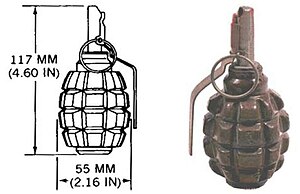This article includes a list of general references, but it lacks sufficient corresponding inline citations. (September 2013) |
| F-1 | |
|---|---|
 F-1 hand grenade | |
| Type | Anti-personnel hand grenade |
| Place of origin | Soviet Union |
| Service history | |
| In service | 1939–present (Russia) |
| Used by | Soviet Union, Cuba, China |
| Wars | World War II Hukbalahap Rebellion Korean War Vietnam War Rhodesian Bush War[1] Six-Day War Yom Kippur War Angolan Civil War Iran-Iraq War Iraq War First Libyan Civil War Syrian Civil War War in Donbas Russian invasion of Ukraine |
| Specifications | |
| Mass | 600 g (1.3 lb) |
| Length | 130 mm (5.1 in) |
| Diameter | 55 mm (2.2 in) |
| Filling | Trinitrotoluene |
| Filling weight | 60 g (2.1 oz) |
Detonation mechanism | Time delay fuse 3.2 to 4.2 s |


The Soviet F-1 hand grenade (Russian: Фугасный > Fugasnyy 1, "Explosive, Type No. 1") is an anti-personnel fragmentation defensive grenade. It is based on the French F1 grenade and contains a 60 g (2.1 oz) explosive charge (TNT). The total weight of the grenade with the fuze is about 600 g (21 oz).[2]
Due to its shape and its yellow-green color, it is nicknamed the limonka (fem. 'little lemon'). It is also nicknamed Efka (Russian: Эфка) for the letter F.[3] It is similar to the American Mk 2 "pineapple grenade", which was also ultimately modeled on the French F-1.
F-1 simulation-training grenade is called УРГ (учебная ручная граната), URG (training hand grenade).
- ^ "Archived copy" (PDF). Archived from the original (PDF) on 2015-08-21. Retrieved 2013-05-03.
{{cite web}}: CS1 maint: archived copy as title (link) - ^ Owen, J.I.H (1975). Brassey's Infantry Weapons of the World. New York, N.Y.: Bonanza. pp. 223–224. ISBN 0-517-242346.
- ^ Yu. Veremeev, "Происхождение "лимонки".